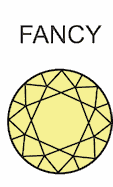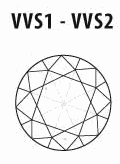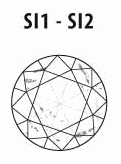Jump to:Learn How to Grade Color –
Learn How to Grade Clarity –
Learn How to Grade Cut –
Learn How to Grade Carat
Learn How to Grade Diamonds
Learn detailed information regarding the 4 C’s of grading diamonds online at Antwerp Or. Detailed information includes how to grade diamond clarity, color, carat and cut.
How to Grade Diamond Color
As a general rule, the whitest diamonds are the most expensive ones. However, exceptions are made when extremely rare colors such as pink or blue are found. During the natural formation of the diamonds billions of years ago, they were not made of pure carbon. One of the main causes for the color having the potential to be so different in diamonds is Nitrogen. This is what gives them their separate colors. Except for these exceptions, an overwhelming majority of diamonds fall from white (being the most expensive) to dark brown or black diamonds (being least expensive).
From an objective scientific perspective, the whitest diamonds are one of the two pillars that make a diamond as pure as possible, the other being clarity. The rarest diamonds are the whitest diamonds, with only the top 20% being sold as jewelry grade (in the higher level shops). We sell fancy colored diamonds on demand. Contact us to ask for specific colors you have in mind, and we will make you the best possible offer.
Diamond color grading chart listed from whitest/most expensive to most yellow/least expensive
1. GRADING COLORLESS DIAMONDS
According to many experts diamond experts and jewelers, it is recommended to set diamonds graded colorless in white gold or platinum. The reason being that yellow gold which causes more of a reflection in the colorless diamonds than white gold, causing your colorless diamonds not to appear as white as they really be. Many jewelers consider using yellow gold on white diamonds a waste of potential, and will choose to display their better quality diamonds in white gold or platinum.
The highest grade quality and most precious in terms of color is the D color diamond. It is very hard for an untrained eye to recognize the differences between D, E and F colors, and the only way to be certain as with all other colors is a certificate. D-color diamonds are considered “colorless diamonds” and are the most colorless.
The second most high grade quality and also second most precious in terms of color is the E grade diamond. As mentioned above, you need either an expert or certificate to be sure of the quality of an E grade diamond as some may confuse it for a D or an F. E-color diamonds are considered “colorless diamonds” and are the second most colorless of all.
The third highest grade quality and also third most precious in terms of color is the F grade diamond. Only a trained expert can tell an F-color diamond for a D-color or E-color diamond. F-color diamonds are considered “colorless diamonds” and are the most third colorless of all.
2. GRADING NEAR COLORLESS DIAMONDS
Near colorless diamonds are still very hard to distinguish, but a person with high average knowledge in diamonds should be able to start seeing a yellow hue. Many do not differentiate between Near Colorless and Near Colorless Slightly Tinted, but we wanted to give you a picture which is as accurate as possible with the strictest standards.
Same as above. An added note for both G-cut and H-cut diamonds is that although someone with substantial knowledge should be able to place them at the G-H range, he will still be unable to tell with certainty to which of the two they belong. Both varieties of near colorless diamonds may not be colorless diamonds, but they are still high-grade.
3. GRADING NEAR COLORLESS SLIGHTLY TINTED DIAMONDS
Starting to show traces of yellow, but still hard to distinguish from other similarly colored diamonds, I-color diamonds are considered by some as Near Colorless and others as Near Colorless with a Slight Tint. It is very clear at this point that the diamond is not very white although it still appears relatively white.
The last of either the Near Colorless or Near Colorless Slightly Tinted diamonds is the J color. Virtually indistinguishable from I, it already begins to show signs of yellow in the proper light. We notice clients are most pleased when selecting a quality of J or above, with yellower colors appearing more yellow than they are in yellow settings, and the yellow really being distinguishable in white settings.
4. GRADING FAINT YELLOW DIAMONDS
Note: jewelers recommend this color range of diamonds be set in yellow gold for bringing out optimal beauty.
Faint yellow diamonds range from colors K, L to M. This range of color starts showing an very light yellow distinguishable by everyone under the proper light. It is still a light color, but everyone can agree at this point that it is no longer white.
5. GRADING VERY LIGHT YELLOW DIAMONDS
This range includes N, O, P, Q, R. A very light but very obvious yellow begins to develop around this point, but it is still substantially more white than yellow. Because of a high statistical likelihood of clients being dissatisfied, most jewelers and diamond dealers prefer not to deal within this range anymore.
6. GRADING LIGHT YELLOW DIAMONDS
Light Yellow Diamonds include range S, T, U, V, W, X, Y and Z. At this point the yellow is highly distinguishable though still relatively light in color, a vast majority of people agree that it is no longer visually appealing to their standards, and would either prefer a lighter color or a fancy color.
7. GRADING YELLOW DIAMONDS
Diamonds can have many colors. Once they reach a true yellow they are no longer able to be categorized under the normal system, but they have their own system. Fancy colored diamonds can range from yellow to dark-brown or even almost black. They also appear in light blue and pink color, but that is extremely rare.
Pictures Showing Range of Differences of Diamond Colors

How to Grade Diamond Clarity
The clarity of a diamond is a factor that highly determines the price of a diamond. The rarest and most exclusive diamonds are the ones with the least possible inclusions.
1. GRADING INTERNALLY FLAWLESS DIAMONDS
This category contains Flawless (FL) in which no inclusions or blemishes can be found under tenfold magnification. Flawless diamonds are very rare and the most expensive.
Internally Flawless diamonds contain no inclusions but small blemishes an expert can see under tenfold magnification. Internally Flawless diamonds are still very rare, with only the top 2% making it into this category and is thus of true jewel grade.
2. GRADING VERY VERY SLIGHTLY INCLUDED DIAMONDS
This category consists of Very Very Slightly Included 1 (VVS1), and Very Very Slightly Included 2(VVS2), with VVS1 being slightly better than VVS2. The amount of inclusions under tenfold magnification is very small, but an expert can see them(with some difficulty). These are top-level diamonds which make up only about 1 in 12 diamonds. This grade is still very befitting for a fine jewel.
3. GRADING VERY SLIGHTLY INCLUDED DIAMONDS
This category consists of Very Slightly Included 1 (VS1) and Very Slightly Included 2 (VS2). A diamond in this category is still and very befitting for a jewel, as only one in six times one may find a diamond of equal or greater clarity. Because VS1 and VS2 are still of very high grade, they are still relatively expensive.
4. GRADING SLIGHTLY INCLUDED DIAMONDS
It is in SI1 and SI2-clarity that diamonds begin to show obvious inclusions that are easily seen under magnification. About a third of all diamonds found make up this grade or higher, making it pretty common. It is at this that the breaking point is for many jewelers when they are selecting clarity for a jewel, and they either prefer higher grade or settle for this as a minimum.
5. GRADING DIAMONDS WITH OBVIOUS INCLUSIONS
It is at this point that a diamond begins to show inclusions large enough to be visible by the naked eye. The lower bottom half of all diamonds mined are of this grade. I1-color diamonds are not recommended for use in a fine jewel.
6. GRADING DIAMONDS WITH VERY OBVIOUS INCLUSIONS
On the lower end of the bottom half in terms of rarity, this diamond grade is one that does not just have inclusions that are viewable with the naked eye, but also starts interfering with reflection of light within the diamond. Most people would not consider purchasing a diamond with such clarity grade and almost every diamond expert and jeweler recommends one not purchase such a stone.
How to Grade Diamond Carat
The word “carat” has a strange origin. The term originates from a 10 metre long tree called “Ceratonia Siliqua”. The tree produces a fruit which produces a pit which consistently weighs 0,2 grams. Because of their remarkable consistency in weight they have been used for over a thousand years for measuring diamonds. Even to this day.
A rough uncut diamond is often much heavier than the cut diamond. For example, a diamond often loses 50%-60% of its weight before reaching its final polished version. The same stone of the same quality will be more expensive if it weighs more carats. It is also important to note that diamond prices increase with a snowball effect when being heavier in carats because they become more and more disproportionately hard to find.
It is for the above reason that diamonds are often examined by a series of professionals before the owner (who also is an expert in this field) finally decides which is the best option in terms of the eventual shape, as other factors relating to quality need to be factored in.
How to Grade Diamond Cut
To find out more about cut types, click here. This section of our page explains the criteria required for knowing how to grade diamond cut quality. The cut type of a diamond determines its comparison to the standard proportions of the diamond shape. The reason for diamond cuts not being ideal is usually because during examination of the stone it was determined by the experts to have the best balance between size and proportion. Ideal proportions bring out the best in a diamond and a high quality cut is crucial for seeing the true beauty of a diamond.
EXCELLENT
Excellent cut diamonds are either perfect according to standard ideals, or extremely close to it. This is the most advised cut quality by diamond experts and jewelers. About 1 out of 25 diamonds are cut to this standard, but Antwerp Or prides itself in having a disproportionately large variety of this cut. This cut sparkles the best.
VERY GOOD
The second best cut variety, the difference is hardly distinguishable but amount of light entering the diamond is affected negatively slightly. About 1 in 8 diamonds are cut to this standard.
GOOD
About 1 in 4 diamonds are cut to this standard. It is still a high quality cut, but most diamond experts and jewelers would recommend a higher quality stone, unless it is of substantial size.
FAIR
It is at this point that the cut starts to deviate significantly from the standard and the sparkle is starting to be significantly negatively affected. Antwerp Or does not recommend purchasing diamonds of this quality.
POOR
The sparkle of the diamond, shape and facets are all heavily negatively affected. We strongly dis-advise purchasing diamonds of this variety, nor do we have them included in our Diamond Builder diamond stock list.
A visual representation of Cut Quality and their outcomes in a Diamond’s light reflection

This picture supplies a good visual representation of how imperfect cuts can lead to imperfect reflections of light within the diamond, showing the importance of cut quality. It is for this reason that we recommend diamond cut quality be as close to the ideal as possible when purchasing diamonds.
Want to learn more about diamonds? Visit Diamond Guidance, for a website dedicated to information about diamonds.



















